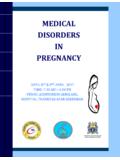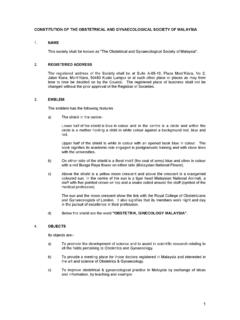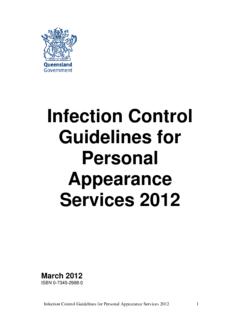Transcription of LAYOUT HPV Layout 1 27/5/2019 12:20 PM Page a
1 LAYOUT HPV_Layout 1 27/5/2019 12:20 PM Page aLAYOUT HPV_Layout 1 27/5/2019 12:20 PM Page bGUIDELINES FORPRIMARY HPVTESTING INCERVICAL CANCERSCREENINGIN MALAYSIALAYOUT HPV_Layout 1 27/5/2019 12:20 PM Page iLAYOUT HPV_Layout 1 27/5/2019 12:20 PM Page iiForewordvList of FiguresviiList of TablesviiAbbreviationsviii1. Cervical Cancer Screening in HPV Vaccination Programme in HPV and Cervical Cancer32. Rational for primary HPV testing53. Objective64. Screening Target age Screening Management for HPV positive cases should follow 6the flow Screening Reporting Personnel65. How to take a cervico-vaginal Self-sampling (vaginal sample) By the health care Cervical smear using Liquid-base96. Requirement for HPV sampling in Health Cervical smear using LBC97. How to prepare the sample before sending to laboratory 98. HPV The The Current available Specimen Transportation of specimen13(will be explained by the manufacturer)CONTENTSLAYOUT HPV_Layout 1 27/5/2019 12:20 PM Page iii9.
2 Analytical Process1310. Result1411. Waste Disposal1412. Reflex Liquid Based Cytology (LBC)1513. Management of HPV Results15(communication of results and audit)14. Diagnosis and Treatment1615. Counselling and options for management1716. Training of healthcare workers1717. Education Material1818. Equipment1819. Quality Assurance For Batch Tests1920. Information system and monitoring2021. Flowchart for HPV DNA Testing21 Appendix 1 : HPV Test/Cytology Request form22 Appendix 2: Pap Smear/Liquid-based Cytology report23 Appendix 3: Molecular Virology HPV Test Result Report24 List of contributors25 References27 LAYOUT HPV_Layout 1 27/5/2019 12:20 PM Page ivGUIDELINES FOR PRIMARY HPV TESTING IN CERVICAL CANCER SCREENING IN MALAYSIAvCervical cancer is the 3rd commonest cancer amongwomen and ranks the 7th amongst Malaysians. Theincidence of cervical cancer has increased from per100000 population in 2011 year to per 100000population in 2018.
3 The National Cancer Blue-Print2016-2020 highlights the ministry s commitmenttowards control and prevention of cancer. Strategies toreduce the impact of cancer include early detection ofcancers, creating awareness, training of healthcareproviders, upgrading infrastructure and equipment forscreening and multiagency of cervical cancer was introduced in 1969, asa family services package, through the Maternal andChild Health Services. Conventional Pap Smear was thescreening method used. Recent findings noted thatnearly 95% of cervical cancer is caused by persistentinfection by oncogenic strain of Human Papilloma Virus(HPV). Once infected with oncogenic strain HPV, it cantake up to 10 years to convert healthy cervical cells intocancerous cells. FOREWORDLAYOUT HPV_Layout 1 27/5/2019 12:20 PM Page vGUIDELINES FOR PRIMARY HPV TESTING IN CERVICAL CANCER SCREENING IN MALAYSIAviThere are two (2) strategies in prevention of cervicalcancer; that is providing HPV immunisation and earlydetection through effective screening.
4 Malaysia hasimplemented the 1st strategy through the introductionof the HPV vaccination to 13-year old school girls in2010. Implementation of HPV vaccination does notremove the need for cervical screening. However, thecountry has to implement a more effective screeningmethod based on recent advances in screening andtesting technology. As recommended by WHO, Malaysiawill implement HPV DNA testing as a cervical screeningmodality. Besides it high sensitivity and specificity, thismethod is said to be able to eliminate barriers faced inthe current cervical cancer screening Pap smearmethod. This guideline is developed to assist health personnelin standardising the cervical cancer screening programas well as managing abnormal results of HPV Screeningtest. I would like to congratulate and thank all the expertswho have contributed towards the development of thisrevised guideline as well as those preceding it.
5 I hopethat this guideline will improve the programmeperformance and achieve the objective of reducing theincidence and mortality due cervical cancer amongwomen in Faridah Binti Abu BakarDirectorFamily Health Development DivisionMinistry of Health MalaysiaLAYOUT HPV_Layout 1 27/5/2019 12:20 PM Page viGUIDELINES FOR PRIMARY HPV TESTING IN CERVICAL CANCER SCREENING IN MALAYSIAviiLIST OF FIGURESF igure 1: Pathogenesis of cervical cancer4 Figure 2: Self-sampling devices7 Figure 3: Self-sampling HPV test English8 Figure 4: Self-sampling HPV Test in Malay Language8 Figure 5: Management of HPV results16 Figure 6: General approach for diagnosis and treatment16 Figure 7: Flowchart for HPV Testing21 LIST OF TABLEST able 1: Some Examples of Available HPV Nucleic Acid12 Test (NAT) MethodologyTable 2: Example of a HPV Test Report14 LAYOUT HPV_Layout 1 27/5/2019 12:20 PM Page viiGUIDELINES FOR PRIMARY HPV TESTING IN CERVICAL CANCER SCREENING IN MALAYSIA viiiABBREVIATIONSAEC-USAtypical Endocervical Cells of Undetermined SignificantASCA typical Squamous CellsCINC ervical Intra-Epithelial NeoplasiaGPGeneral PractitionerHIVH uman Immunodeficiency VirusHPVH uman Papilloma VirusHSILHigh Grade Squamous Intra-Epithelial LesionIPESI ntegrated Package of Essential ServicesIPPFI nternational Planned Parenthood FederationLBCL iquid Based CytologyLSIL/ LGSIL Low Grade Squamous Intra-Epithelial LesionMOHM inistry of HealthNATN ucleic Acid TestPCRP olymerase Chain ReactionHSILHigh Grade Squamous Intra-Epithelial LesionSCCS quamous Cell CarcinomaSILS quamous Intra-Epithelial LesionSTIS exual Transmitted InfectionLAYOUT HPV_Layout 1 27/5/2019 12.
6 20 PM Page viiiGUIDELINES FOR PRIMARY HPV TESTING IN CERVICAL CANCER SCREENING IN Cervical Cancer Screening in MalaysiaCervical cancer screening in Malaysia using conventional Papsmear was initiated in 1969. It was initially introduced to all familyplanning acceptors. The importance of cervical cancer screeningwas further enhanced in 1995 when cancer was chosen to be thetheme of the Healthy Lifestyle Campaign. It became a nationalprogramme in 1995. The service later was expanded with thedevelopment of the National Pap Smear Screening Programme in1998, to all eligible women age 20 65 years old yearly for the first2 years and 3 yearly subsequently if the result are normal. Its mainobjective were prevention and early detection of cervical cancerand ensuring early treatment as well as proper follow up of patients(Division of Family Health Development, 2004). Every eligible woman is encouraged to come forward to have theirPap smear test done according to the schedule.
7 The programme iscarried out opportunistically, where women who attend the clinicfor health screenings will be offered Pap smear screening. The Ministry of Health provide sapproximately 75% of the Papsmear screening in the country without incurring any cost to thepublic. On the other hand, about 25% of the Pap smear screeningservice is provided by other agencies such as university hospitals,private facilities and non-government organisation but the womenare required to payfor the tests. The main modality used forcervical cancer screening in the Ministry of Health facilities isconventional Pap smear, however, liquid-based cytology has beengradually introduced in 2014 to replace the conventional Papsmear. Liquid-based cytology (LBC) is a screening technique whichisdeemed superior tothe conventional Pap smear (Strander,Andersson-Ellstr m, Milsom, R dberg, & Ryd, 2007). In Malaysia,Liquid-based cytology has been initiated for cervical cancerscreening in 2014 in several states namely Kelantan, Johor, NegeriSembilan and Selangor (Division of Family Health Development,2004).
8 HPV_Layout 1 27/5/2019 12:20 PM Page 1 guidelines FOR PRIMARY HPV TESTING IN CERVICAL CANCER SCREENING IN HPV Vaccination Programme in MalaysiaWith the announcement made by WHO in 2006, on the availabilityof effective, safe new HPV vaccines to prevent cervical cancer(United Nations Population Fund), the Ministry of Health, Malaysia(MOH) examined the possibilities of introducing HPV vaccinationin Malaysia as a primary prevention strategy in addition to theexisting cytology screening. The decision to proceed to this strategywas supported by local and international cost effectivenessstudies. Aljunid, et al (Ezat & Aljunid, 2010) who led a study on thelocal mathematical model of HPV vaccine, projected that theintroduction of HPV vaccination will potentially prevent 89% ofcervical cancer and save substantial annual cost for HPV-relatedtreatment. Other considerations included vaccine efficacies (WorldHealth Organization, 2017), high immunogenicity amongadolescent, prophylaxis property of the vaccine and strategy of prevention which is vaccinating girls beforetheir sexual debut, and therefore before exposure to HPV infection,provides an excellent opportunity to decrease the incidence ofcervical cancer over time.
9 The National School-based HPVI mmunisation Programme was launched in April 2010 targeting atthe 13 yrs or Form 1 Malaysian female school children. Thisnational programme was implemented in 2,958 public and privatesecondary schools registered under the Ministry of Educationthroughout Malaysia. The consent forms and printed HPV healtheducation materials were delivered to the parents through schoolteachers one week prior to the first dose vaccination. This was donethrough scheduled school visits by the various school health teamsat district level to ensure HPV vaccination spaced at the month 0, 1and 6 must be completed within the same year. In 2017, in line withthe SAGE (WHO) recommendation, the adolescent students weregiven only 2 doses of the HPV vaccine. LAYOUT HPV_Layout 1 27/5/2019 12:20 PM Page 2 guidelines FOR PRIMARY HPV TESTING IN CERVICAL CANCER SCREENING IN HPV and Cervical CancerIn Malaysia, the incidence of cervical cancer (age-standardizedrate) has increased to per 100,000 population in 2018 (WorldHealth Organization, 2018) compared to per 100,000population in 2011 (Azizah, Nor Saleha, Noor Hashimah, Asmah, &Mastulu, 2016).
10 It is the third commonest cancer among women inMalaysia. The incidence increases at 35 years and peak between50-74 years cancer is a rare outcome of an unresolved HPV (oncogenic)infection, currently defined as persistent presence of HPV DNA inrepeated testing of cervical specimens. Human papillomavirus(HPV) is the most common viral infection of the reproductive sexually active women and men will be infected at some pointin their lives and some may be repeatedly peak time for acquiring infection for both women and men isshortly after becoming sexually active. HPV is sexually transmitted,but penetrative sex is not required for transmission. Skin-to-skingenital contact is a well-recognized mode of of HPV types do not cause problems. HPV infections usuallyclear up without any intervention within a few months afteracquisition, and about 90% clear within 2 years. There are about40 genital HPV types, 14 are classified as oncogenic as they areassociated with anogenital cancer, including squamous andadenocarcinoma of the cervix.












